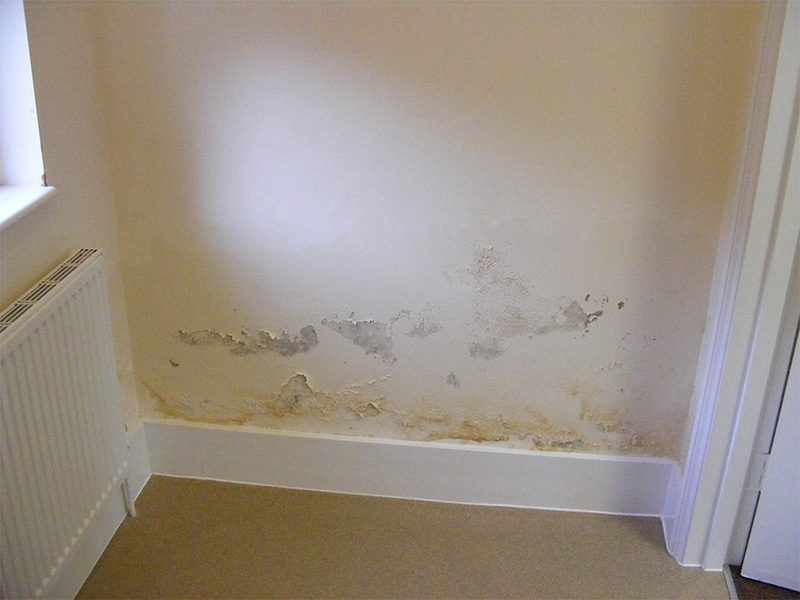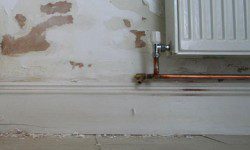Our fully qualified surveyors are able to determine the presence of rising damp and provide you with a suitable, professional solution.
What is rising damp?
Rising damp is a process whereby moisture contained within the ground travels vertically through the capillaries of a structure, which is referred to as ‘capillary action’. Properties built after 1875 are likely to contain an original damp-proof course (slate, bitumen etc.), however, if a damp-proof course has either failed or has been compromised i.e. bridged, then rising damp can occur.
As water rises from the ground, salts that are naturally contained within the earth (mainly chloride and nitrate salts) can be transmitted in solution. When this rises to a certain point, evaporation naturally occurs leaving the aforementioned salts within the plasterwork and brickwork.
Chloride and nitrate salts are known to be ‘hygroscopic’ meaning they are able to attract moisture from the atmosphere which in turn, can cause staining and deterioration to a finished surface.
How to identify rising damp?
There are some clear signs that can give property owners an indication that your property is suffering from rising damp without the assistance of a surveyor. Identifying signs earlier will help you to be able to deal with the damp problem as quickly as possible.
Tidemarks and damp stains on walls
One of the most recognisable rising damp signs is if there are tidemarks on your walls. They will be horizontal brown or discoloured marks at low level on walls.
The reason for these tidemarks to occur is due to the migrations of salts where the evaporated damp has risen up the walls from the ground.
Wet patches on walls
If the walls in your property appear to have damp or wet patches, then it is possible that rising damp is causing the problem. In order for rising damp to occur, these patches must be on the lower parts of the wall and on the ground floor of the building.
The process of rising damp is through capillary action with moisture moving up walls through pores of the bricks, mortar or stonework.
The main form of protection to stop rising damp is a damp proof course and, if it is damaged, bridged or does not exist in the first place, then your property is vulnerable to rising damp.If your damp problem is occurring above the ground floor of the building, then it will be other damp issues which are causing the problem, e.g. condensation or penetrating damp.
Peeling wallpaper
Another key sign that rising damp is occurring, is the peeling of wallpaper. If there is sustained dampness in the property, the walls will be full of moisture. The more moisture you have in the property, the more chance the wallpaper will start to peel off the wall.
Bubbling or flacking plaster on wall
Flaky or bubbling plaster is often a symptom of rising damp. You will most likely find that plaster will be crumbling, or deposits of plaster will be on the floor. This is due to residual salt contamination and high levels of moisture which causes the plaster to weaken over time and eventually fall off.
This problem causes obvious distress for many homeowners across the UK, as not only does it not look aesthetically pleasing, but it can also prove costly to fix.
Wooden beading and skirting boards begin to rot
Leaving rising damp untreated for a long amount of time can lead to serious problems occurring further down the line. For example, your skirting boards and flooring timbers may begin to rot.



How is rising damp caused?
Rising damp is caused by the rising of groundwater through the capillary action. If your property does not have a damp-proof course (DPC) in place, then the building is vulnerable to rising damp occurring.
This type of damp mainly occurs in older buildings pre the 1950s. As this is a problem that has been occurring for years, most modern housing has a DPC installed at the initial construction phase.
The original damp proof course can be made up from plastic, slate and bitumen; It will just depend on what period the building was built. There is also the issue that DPC can be bridged, which occurs if there is a construction fault with the building, resulting in damp being able to travel past the DPC from the ground.
Examples of construction faults that can occur are;
- There is debris in the cavity wall
- The internal render or plaster is bridging the DPC
- Ground levels around the building have been raised above the DPC
What problems does rising damp cause?
Rising water causes problems of decorative spoiling and especially rot in skirtings, floor joists, floorboards and wall plates, where present. Significantly, ground water salts will be deposited within the masonry and the surfaces, especially plasters and decorative finishes.
Most groundwater only contains very small quantities of salts at levels which are generally at an acceptable level.
However, as the water rises within the wall, these salts are carried up into the wall and left behind as the water evaporates.
And here is where a further problem with long term rising damp occurs. A proportion of the salts are hygroscopic. This means that they can absorb water from the air.
In some cases, these salts are concentrated to such levels that sufficient water is absorbed from the air to cause contaminated finishes to appear damp.
This will cause future problems, in that if the rising damp is stopped, materials may still remain damp solely due to the hygroscopic nature of the contaminated material. Any decorative finish applied to such contaminated substrates would almost certainly spoil with time.
If rising damp starts to affect the timber structures of your building, then one of the outcomes that can be caused is dry rot. Dry rot is a wood rotting fungi that can spread throughout your property, causing damage to the structural integrity of the building.
How to treat rising damp?
One of the main steps to treating rising damp is identifying the source of the damp problem. Carrying out quick fixes will only cover up the issue for a short period of time, therefore, make it more expensive for you to solve long term,
One solution for treating rising damp at your property is the installation of a damp proof course. For a professional rising damp treatment service, RTC will provide an experienced surveyor who will visit your property and outline potential damp proofing treatments and costs.
Below are the methods that are used to treat rising damp from your property:
Rising damp survey
The first step to treating rising damp is to have a survey carried out by a qualified surveyor. Condensation, penetrating damp and rising damp all have similar symptoms. This makes it easy for the untrained eye to misdiagnose rising damp for other types of damp.
it is important to have a surveyor who has the experience and knowledge of damp to inspect the property for all damp issues and provide the best rising damp treatments for your property.
Damp proof course
Most modern properties are often built with a damp proof course installed, usually in the form of an impermeable plastic membrane, which is placed along a mortar line near the ground.
Older properties, however, are often built with no damp proof course, or the original course may have failed over time.
If your property is in need of a damp proof course, there are a number of methods that our team of qualified technicians can implement.
What happens if rising damp is left untreated?
If rising damp is left untreated, then it can lead to serious issues with the structural integrity of your property. If left, the rising damp problem will worsen, potentially causing further damp related damage. This will ultimately then lead to increased costs to rectify the problem, that could have been a relatively small damp proofing job.
Any decoration that you have added to your home, such as wallpaper or plaster, will deteriorate, increasing costs further. If you are in the process of selling your home, a damp issue makes the process longer and may delay the sale.
The misdiagnosis of rising damp
Misdiagnosing rising damp from other forms of dampness is not uncommon. This is why it is important to employ the services of a qualified damp specialist to correctly identify the type of dampness in the property. One common misdiagnosis is that if you see a tide mark on your wall, it is automatically assumed that it is a rising damp problem, and in a lot of cases it is not.
Are rising damp treatments covered by guarantee?
Yes, if rising damp treatments are carried out by RTC, it comes with the protection of a long term guarantee.
This provides you with the reassurance that if in the unlikely event that something goes wrong with the treatment or rising damp starts to re-appear, then we will be on hand to fix the problem.
What is the cost of rising damp treatment?
“How much does rising damp treatment cost?” is one of the most frequently asked questions by homeowners with a damp issue. The cost of the damp proofing is subjective to a number of variables including; property size, location and accessibility.
The type of damp proofing system to be installed also has an effect on cost. Replacing an existing damaged physical damp proof course with a new one is a very difficult process that would almost certainly involve large amounts of structural work taking place. For that reason, the most common and cost effective treatment for rising damp is to install what is known as a chemical damp proof course.
Can rising damp cause health issues?
This question is the one that is asked all the time. In many cases, if treated in good time, damp won’t be a concern for your health.
If left unchecked, it can cause damp musty smells and cause properties to be colder and less thermal efficient and depending on the occupants this could have some health issues however, generally the health risks aren’t a real issue as long as the damp problem is resolved.


